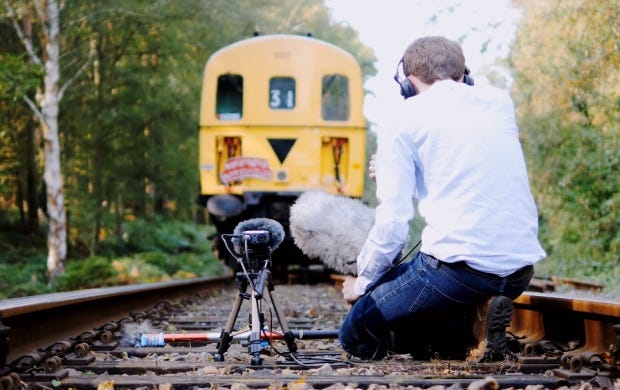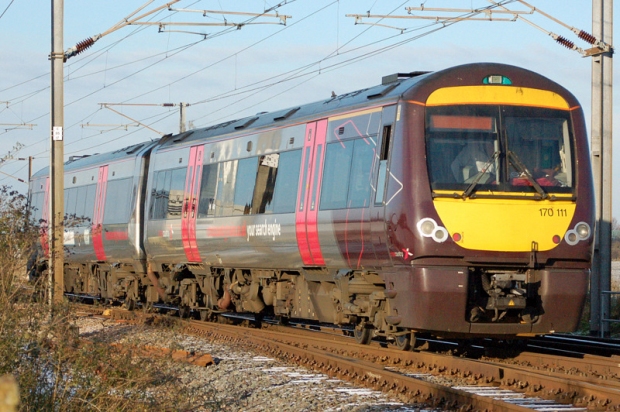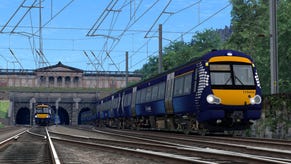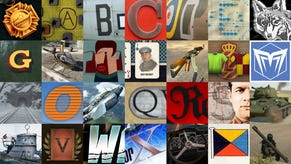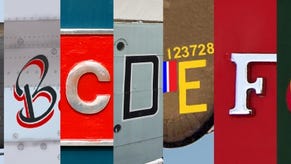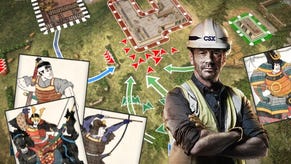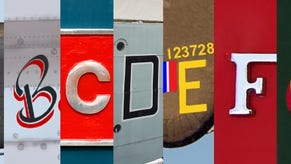The Flare Path: The Man Who Listens To Trains
Armstrong Powerhouse interviewed
In the light industrial districts that have sprung up around FSX, X-Plane, and DCS World, genuine craftsmen aren't all that hard to find. The machine tools that whirr and thump and whine in the workshops of add-on makers like A2A Simulations and PMDG are operated by passionate perfectionists - driven micrometer wielders whose scrap bins brim with components that look, on first, second and third inspection, absolutely flawless. Elsewhere in Simulatia, it's a different story. Just about the only sim that can boast a third-party add-on as lovingly fashioned as this Texan or this Fishbed, is Train Simulator. I enthused about that add-on - a delightful Class 205 DEMU - a few weeks ago, and in today's Flare Path I talk to the outfit behind it, Armstrong Powerhouse.
RPS: What did you and your colleagues do before you recorded and recreated rolling stock for a living?
Richard Armstrong: I set up Armstrong Powerhouse a few days before starting my first year of Sixth Form in August 2008 and at first, it was just meant to be a casual occupation on the side. It soon became clear though that there was a real demand for sound enhancements in Train Simulator so the studies soon went out of the window and I focused all my attention on trying to make a full time business of it. As a result, this is the only work I’ve known!
Our chief 3D modeller, Jordi Blumberg, who is responsible for the Class 205 DEMU Pack, was part of a flight simulator development group for several years before turning his attention to trains.
RPS: How do you go about selecting new projects?
Richard: This might sound like stating the obvious but it pretty much comes down to what we feel is most in demand at that moment in time. There is also the factor of what I, personally, would like to see in the simulator and from experience, this usually seems to tally with our customers. When it comes to sound packs though, we are limited by the trains we are able to gain access to record, so whilst I’d love to do a class 170 sound pack for example, this hasn’t been possible so far due to being unable to record one.
RPS: What equipment do you use on your sound-gathering trips?
Richard: We had our first formal recording session in October 2011, at the Gloucestershire & Warwickshire Railway, to record a class 20, 37 & 47. For this, we used a single Zoom H4N recorder in combination with a Rode NTG2 shotgun microphone. This was quite a learning experience and it soon became apparent that a standard windshield is not sufficient to eliminate wind noise on the move. As a result, we invested in a blimp which improved things dramatically.
Since then, we’ve acquired two additional Zoom H4Ns to allow us to record simultaneously in various locations of a locomotive such as both cabs and the engine room. The Rode microphone does a good job but for the loud sounds like an engine’s exhaust or horn, I didn’t feel it was quite capturing the feel of the sound well enough, so in October of last year, we purchased a Sennheiser MKH-416 microphone to replace it. The difference in quality of the two is quite significant and hopefully that can be heard in the Class 205 DEMU Pack, and also the class 37 sounds featured with our Wherry Lines route.
RPS: Do your recording sessions follow a standard format?
Richard: Pretty much, yes. In the case of a diesel locomotive, we’ll firstly record the engine at a variety of constant power settings to achieve the loopable sounds that are played when the player is neither powering up or down. After that, we then go through a list of all the possible permutations on how a locomotive can power up. Once they are sorted, the engine is shut down which allows us to record static sounds such as the cab handles/switches and horns without any background noise. Finally, the engine is started back up and all being well, we have a full set of recordings to put into Train Simulator.
RPS: What's been your most challenging recording excursion thus far?
Richard: Our last one at the Mid Norfolk Railway in August was probably one of the most challenging! We were recording a class 47 and the day started off well as we trundled down from Dereham to Wymondham. Halfway there though, at a station called Kimberley Park, we were informed that a tractor had struck a bridge further along the line and as a result, we wouldn’t be able to go any further for the foreseeable future. Hoping that the wait wouldn’t be too long, we took this opportunity to shut down the engine and record the static sounds. After covering these, the line still hadn’t re-opened so a plan was drawn up to return to Dereham where we could have a lunch break and then set out again later in the day to Wymondham.
With just a locomotive and 6 coaches though, we weren’t able to head for Dereham with the locomotive leading so the plan was to propel via the use of radios to Thuxton, where there’s a passing loop, and run the locomotive round so it was facing the right way. This all sounded good to me so off we went. To add a further complication though, on the way back to Thuxton, one of the tied on microphones hit an obstruction and as a result, the boom pole was severely bent and had to be removed as soon as possible. After a hasty stop, the pole was removed and we carried onto Thuxton. Yes this was a pain but with a spare boom pole in the boot of my car at Dereham, I’d be able to tie the microphone back on once we got there. The trouble was, we never did!
Upon arrival at Thuxton, the manager of the railway contacted us to say they needed our train to pass over the bridge that had been hit, to check it was structurally okay. There goes lunch and a replacement boom pole! As a result, we had to make the best of what we had so with some help from my recording colleague, we snapped the boom pole where it was damaged, and cable tied the two parts together to allow us to re-tie the microphone to the locomotive, making sure to place it lower than before so the same thing didn’t happen again! The trouble was though, now that the microphone had moved, the previous recordings would sound too different to the ones to come, to be used together in a sound pack. This meant starting the recording process all over again and with time getting on, we’d be pushed to get everything we needed.
Regardless though, we pressed on towards the bridge where we were greeted by the sight of the affected tractor and a couple of police cars. We then proceeded over the bridge at 5mph with our fingers (and everything else) crossed. There’s something a little unnerving about travelling over a potentially damaged bridge with a 122 ton locomotive but we made it! From then on, we managed to carry on recording without disruption to Wymondham, where we ran round and headed back to Dereham. By then though, it was 5pm and there simply wasn’t time for another trip of the line. I wasn’t satisfied that we’d recorded all we needed to but we had to call it a day.
Despite everyone’s best efforts then, that day just wasn’t to be and we’ll be returning later this month to try it all again.
RPS: Are there any overseas subjects you'd particularly like to tackle?
Richard: Overseas railways are certainly of interest to me but with so much to do in Britain, it sadly doesn’t make commercial sense to take on anything like this with its increased research and development costs. Also, with an Armstrong Powerhouse product, I like to take pride in the attention to detail that we’re known for and I’m not confident I have the required knowledge to do foreign traction justice.
RPS: Where will your next sound gathering expedition take you?
Richard: As mentioned before, we’ll be visiting the Mid Norfolk Railway again at the end of September to record the class 47. Beyond that, we’re currently working with Arriva Trains Wales to bring sounds to a simulator they’re developing for staff training and part of that will involve visiting their depot at Machynlleth to record a class 158. Fans of our Facebook page will see that we’ve already visited Cardiff to record a class 150 & 175 for this purpose. Whilst this is primarily for Arriva Trains Wales’ simulator, these sounds will also see the light of day as a traditional sound or enhancement pack in Train Simulator.
RPS: Do railway companies and heritage lines charge a standard fee for loco and multiple-unit access?
Richard: Railway companies and heritage lines are two completely different kettles of fish. With heritage lines, where they are used to individuals chartering their trains, you are usually able to approach them and request you’d like this locomotive, for this amount of time, on this part of the line, and they’ll supply a quote. This can range from as little as £300 to £1000+. Whether we can handle that fee depends on how popular we think the resultant product will be!
With railway companies though, it’s a lot harder and this kind of thing is often too niche for them to have any kind of procedure in place. As a result, you usually need to know, or be contacted by a like-minded rail enthusiast within the industry, who can pull some strings to get something sorted. One example of this was in February of last year where we posted on Facebook to ask if anyone was in the position to help us obtain this kind of access. A keen simmer who works for GB Railfreight responded and by May, we were able to record a class 66 diesel locomotive. In return, we made a donation to the company’s charity which was a great way of saying thank you for their help.
RPS: Do you only sell sounds to simmers or do others like model railway enthusiasts also get to enjoy the fruits of your labour?
Richard: We concentrate just on train simulation as to be honest, there’s so much to go at, there’s not time at the moment to diversify into other areas. The other more primary reason though is that I often record with ‘legomanbiffo’, a well regarded provider of sound for model railways. We help each other in pooling our contacts within the rail industry and also sharing the cost of recording sessions, so we have no intention of stepping on each others’ toes.
RPS: Are there inherent limitations in TS2016 that you find frustrating?
Richard: Originally there were a lot, but through the use of lua scripting, we’ve been able to overcome many of the limitations built into the basic features of the simulator. One hard limitation though, which is becoming increasingly apparent with the proliferation of rolling stock using larger and more numerous textures, is the memory limit. If you press Ctrl+Alt+Del whilst using Train Simulator, you can see its memory usage and for as long as it stays below 3GB, you will usually be okay but should it start creeping towards 3.5GB, there seems to be a hard limit where the simulator simply crashes. This is perhaps related to it being a 32-bit only application. As a result, in some busy scenarios, we’ve had to remove items of rolling stock to reduce memory usage make the scenario playable. We are overcoming this though by being as economical with textures as possible. For example, whilst the Class 205 DEMU Pack is arguably one of the most visually impressive items to be seen in the simulator to date, it’s memory usage is actually really quite modest and in many cases, less than equivalent pieces of stock available in the simulator.
RPS: What does the recent Train Sim World announcement mean for AP?
Richard: Hopefully it’s a good thing! The main issue is that to date, Train Simulator has been really quite an open piece of software and tools are provided for individuals to produce enhancements and fully featured packs. Whether that’s via Steam or an independent site such as Armstrong Powerhouse. For this, we are very grateful to Dovetail Games and we genuinely believe it helps further the hobby by allowing specialists to come in and do things that wouldn’t necessarily be financially viable or possible for an organisation like Dovetail Games. That is the big question looming over Train Sim World though; will this open policy be continued or will third party content be restricted.
RPS: I've a theory that because aural and physical shorthand is far more difficult for humans to process than visual shorthand, detailed sound and physics is more important in a PC simulation than detailed graphics. Would you agree?
Richard: I 100% agree with this. Ever since I first started using Microsoft Train Simulator in 2001, I’ve always been more interested in how a train sounds and works rather than how it looks and this still holds true to this day. For me, I can still quite happily drive a train if it sounds good and handles well but doesn’t look great. If it looks incredible and sounds poor though, I can’t drive it for long without losing all interest. That’s why I’ve always focused on producing sound enhancements, as I think it’s the single most important thing to feeling immersed in the simulator.
RPS: What, in your opinion, is the loveliest sound to be heard on the British rail network today?
Richard: I hope you’ll forgive me for dividing this question into four categories:
Diesel locomotive: Class 37 – Just for the sheer volume and raucous note of the exhaust. On a still night, you can often hear these 2 or 3 miles away.
Electric locomotive: Class 91 – The loud fans on these are very distinctive and make a great sound when passing at speed. The horn is also quite unusual in that the high tone plays both the low and high tone together. This results in a discordant effect which is rather reminiscent of the old chime whistle fitted to their predecessors, the A4 pacific steam locomotive.
Diesel multiple unit (DMU) – Class 205/207 – Must DMUs tend to sound like a bus but this one is unusual in sounding a lot like a classic diesel locomotive. The whine of the engine turning over at idle and the thumping under power is something that’s stuck with me since I was a child.
Electric multiple unit (EMU) – Class 319 – The old DC motors on these are very loud and can be quite an experience at high speed with the windows open, especially through a tunnel. This is something that is lost on modern trains with their sealed air-conditioned environments; the sensation of speed is disappearing.
RPS: Thank you for your time.
* * * *
